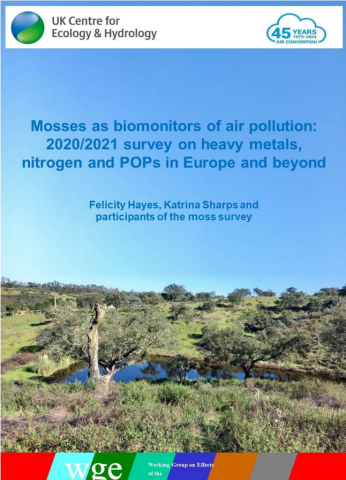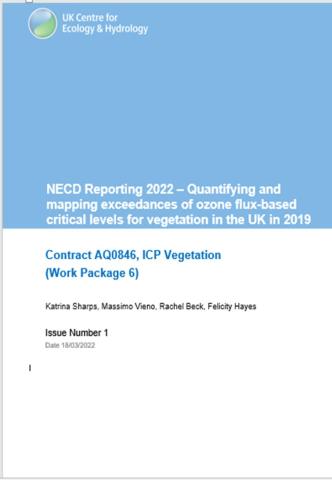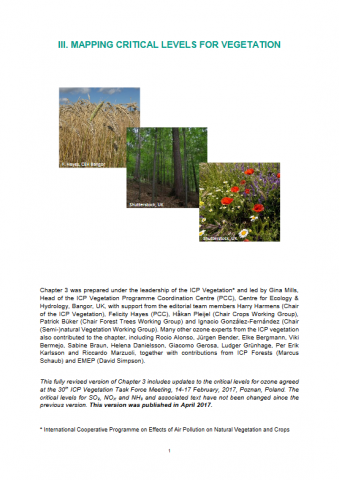Today, 7th September 2020, is the International Day of Clean Air for Blue Skies, hosted by UNEP (the United Nations Environment Programme).
The main aims of the day, which will be celebrated globally and repeated on September 7th in the years to come, are:
a) To raise awareness of the topic in general (sources, effects (incl. on plants), abatement measures, links to other environmental challenges such as climate change);
b) To share best practices how to combat air pollution and its effects;
c) To form a global network of organisations, policymakers, research institutes etc. that will put this topic on the international stage.
Air pollution can have a negative impact on vegetation. Tropospheric (ground-level) ozone is considered one of the most damaging phytotoxic air pollutants. Ozone is a secondary air pollutant and a greenhouse gas. It is produced from reactions between the primary air pollutants nitrogen oxides (sources: transport and industry) and volatile organic compounds (sources: petrol, natural gas, paints, certain tree species) during warm and sunny weather. Surface ozone concentrations vary around the world. While in recent years, ozone levels have become more stable in Europe and have declined in North America, levels in rapidly developing regions continue to rise. Ozone is a transboundary pollutant, meaning that precursors can travel far from their point of production before ozone is formed. Ozone concentrations can be particularly high in rural areas downwind of cities.
Ozone is absorbed via the leaf pores (stomata) of plants, leading to cell wall and membrane damage and the disruption of photosynthetic processes. This can result in the appearance of visible injury on leaves and a reduction in the quality and quantity of plant biomass and crop yield in sensitive species. Visible ozone injury occurs between the veins on older leaves, with small bronze, brown, or yellow spotting/flecks appearing on the upper leaf surface. In severe cases, the flecks can join to form large lesions covering most of the leaf surface. The identification of visible injury is a low cost method of determining if a species is being negatively affected by ozone pollution, leading to potential impacts on yield/biomass. This is particularly useful in countries where it may be difficult/impractical to carry out detailed field experiments on the impact of ozone.
The effects of ozone on crops have been studied using a variety of ozone exposure methods (e.g. closed chambers, open-top chambers, solardomes, field release systems). Ozone exposure can lead to a decrease in total grain yield, individual grain weight, and grain quality. Visible damage to ozone sensitive leafy crops can also negatively affect crop quality and therefore market value. Crops species vary in their sensitivity to ozone. Sensitive species include soybean, common bean, pulses, wheat, and to a lesser extent rice, potato and maize. As these crops are staple food sources across the world, ozone pollution has the potential to impact food security. The impact of ozone on food security in Europe has been studied, with eight of the nine crops with the highest production in Europe being sensitive or moderately sensitive to ozone. More recently, ozone impact on African crop cultivars has been investigated, with results showing a negative effect of increased ozone on the yield of African wheat cultivars and widely grown common bean cultivars.
Common bean (Phaseolus vulgaris), Black Turtle cultivar, growing under three levels of ozone exposure.
Different cultivars of the same crop can also show varying sensitivity to ozone, suggesting scope for advising crop farmers on which cultivars are less sensitive to ozone, and potential for breeding ozone-tolerant cultivars. However, this needs to be balanced with other favourable characteristics, such as fast growth, high yield and drought tolerance.
Extensive research on the impact of ozone on trees has also been carried out, including epidemiological studies, allowing investigation of interactions between ozone and other pollutants (e.g. nitrogen) and environmental variables, which can be difficult to study in simulated experiments. Ozone sensitive tree species include birch, beech, Norway spruce, poplar and oak. Ozone impacts on trees include visible injury on leaves, an increase in the rate of leaf senescence, a reduction in growth/biomass (and therefore reduced carbon sequestration), and increased crown defoliation (a general indicator of forest health).
The International Cooperative Programme on Effects of Air Pollution on Natural Vegetation and Crops (ICP Vegetation) was established in 1987 to consider the underlying science for quantifying damage to plants caused by air pollutants, particularly ozone. Now, over 250 scientists from ca. 50 countries participate in the programme, which is part of the activities of the Working Group on Effects (WGE) under the Convention on Long-range Transboundary Air Pollution (LRTAP Convention). The ICP Vegetation collates evidence of ozone impacts on vegetation (for example from field surveys and ozone exposure experiments); develops ozone dose-response/flux-effect relationships to establish safe thresholds (critical levels) for ozone impacts on vegetation; models and maps impacts of ozone on vegetation from local to global scale; and studies interactive impacts between ozone pollution and climate change, and interactive impacts between ozone and other air pollutants such as nitrogen on vegetation. A smartphone app has also been developed to allow users to submit records of incidences of visible ozone injury on vegetation. For further information on the ozone impacts on trees, also see ICP Forests.
Mitigation options for ozone damage include management strategies, including timed/controlled irrigation for crops and breeding of ozone-tolerant cultivars. However, ultimately, global‐scale international efforts are required to reduce the emissions of ozone precursors.
The International Day of Clean Air for Blue Skies is a global call for action toward a single, unifying objective: clean air for all.
On 7th September 2020, it will be celebrated for the first time ever, urging countries to work together to tackle air pollution.


